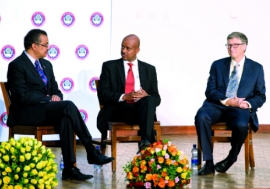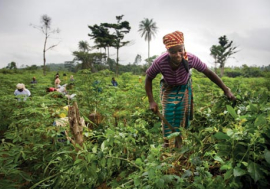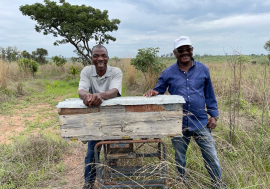Africa’s food policy needs sharper teeth
Africa’s food policy needs sharper teeth
AS THE AFRICAN UNION MARKS 2014 AS THE YEAR OF AGRICULTURE AND FOOD SECURITY, this special edition looks at the many challenges and opportunities facing Africa’s agriculture – from land issues, to investments and innovations inspired by information technology, to the important role played by women in fighting hunger and malnutrition. It mixes new and updated stories that have been previously published in Africa Renewal over the past few years.
Amid raving economic forecasts that Africa will be the next big emerging market, chronic food shortages remain stubbornly immune to solutions. The African Union is aware of this weak link and is working to convince its members to boost investments in agriculture. To emphasize the central role of agriculture in Africa’s economic growth, the regional body has declared 2014 as the Year of Agriculture and Food Security.
Convincing leaders to treat agriculture not only as a solution to end poverty and hunger but also as a major contributor to economic development deserving of public investments is a tall order. It demands strong political commitment and an enlightened leadership. But there are signs of progress, thanks in part to an innovative programme by the AU’s development agency, the New Partnership for Africa’s Development, called the Comprehensive Africa Agriculture Development Programme (CAADP), which marks its 10th anniversary this year.
Powerful message
CAADP’s message is simple but powerful: More investments in agriculture will end hunger and lift millions out of poverty. The programme has several elements, but the best-known requires signatories to spend at least 10% of their budgets on agriculture and to strive for an annual 6% growth in agriculture. As of end of December 2013, 40 countries have signed up for the programme, but only nine have attained the 10% target.
CAADP’s scorecard so far is mixed. Some countries are still grappling with the teething troubles of translating its plans into action. But those that have faithfully put the programme into action are seeing positive changes. For example, Rwanda, the first country to adopt the programme in 2007, increased the land allocated to maize production almost five fold in three years. As a result, maize harvests rose by almost 213% – from less than 0.8 tonnes per hectare to 2.5 tonnes – over the same period. Malawi also scored comparable successes – before the government reduced support to agriculture when faced with a budget crisis in 2012 – along with Sierra Leone and Tanzania, among others. Since 2003, Africa’s annual agricultural growth has averaged nearly 4%, well above the growth rates for the previous several decades.
While several countries have made inroads in tackling the challenges of hunger, undernourishment and extreme poverty, Africa remains a net food importer and produces far less than its potential. The chief culprits are bad policies and, to a lesser extent, the vagaries of weather. Thailand’s food exports, for example, are valued at more than the combined value of the whole of Sub-Saharan Africa’s food exports.
Africa’ plan to revamp agriculture through CAADP is a noble idea. Yet it suffers from two major weaknesses: governments don’t have or are unwilling to commit enough money to back its plan and CAADP has no power to compel members to adopt its recommendations.
CAADP needs funds
Take the European Union’s farm subsidy programme, the Common Agriculture Policy (CAP), for instance, which was created in response to severe food shortages in Europe back in the 1950s. CAP has money — in 2013 it was gobbling up about 40 per cent of the EU’s budget — and the power to impose conditions on members that get subsidies. True, EU subsidies hurt farmers in poor nations, but they have raised the incomes of EU farmers and produced more quality food for consumers.
In contrast, CAADP uses moral suasion to induce members to stick to their commitments. Worse still, it relies heavily on donors for investments in countries that have signed on. Equally troubling is that a big chunk of the national budgets of most CAADP signatories comes from donors, subjecting Africa to aid cuts whenever donor economies slump or priorities shift, or when domestic African political fortunes change, as events in Malawi, Rwanda and elsewhere have clearly shown.
CAADP can be effective, but only to the extent that signatories are committed to doing the necessary heavy lifting. To demonstrate its commitment to food security, the AU should move beyond platitudes and follow the EU’s example — make it mandatory for members to contribute to a common fund for agriculture. Each member’s contribution could be based on its ability to pay, perhaps using GDP per capita as a guide. Such a fund could then be used to reduce CAADP’s dependence on donors. To its credit, the AU has set up a foundation to raise project funds from individuals and the private sector. It’s a modest but encouraging practical step that shows that the AU intends to go beyond mere platitudes of goodwill.
True, setting aside a tenth of the budget for agriculture is a big deal for poor countries often faced with competing priorities. But success in agriculture reduces the pressure to finance solutions to social problems caused by hunger and poverty. Putting money into agriculture is a smart investment.






















